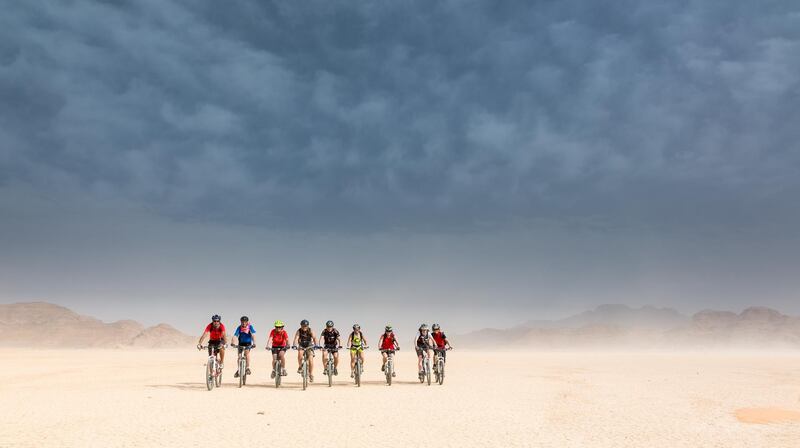“Go cycling in Jordan,” they said. “It’s fine for beginners.”
I'm just a few hours into my biking adventure when it dawns on me that Jordanians are fond of storytelling. After a warm-up cycle of 40 kilometres, we've stopped – nay collapsed – at the side of a dirt road, after puffing our way up a final ascent. That's not a typo; our warm-up was a 40km cycle, or the equivalent of 400 football fields, draped across uneven terrain with ascents of up to 1,500 metres. Not quite what I'd call a beginner's ride.
Yet, when put into the context of the official trail, I can understand why this is deemed a mere warm up. In its entirety, the Jordan Bike Trail stretches 730km from Umm Qais in the north to the southern port of Aqaba. Cyclists ride over rolling hills, rock-strewn peaks and rural farms before speeding south towards the endless landscapes of Dana, the famed structures of Petra and the red dunes of Wadi Rum. It ends near the Red Sea and is physically challenging, criss-crossing over wadi-filled terrain and dirt track roads, reaching up to 20,000 metres in elevation.
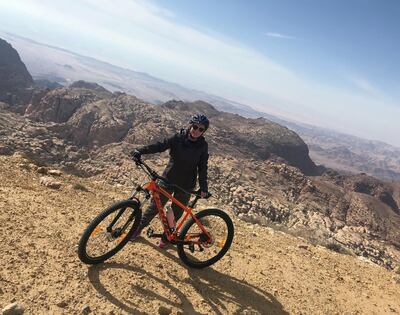
Luckily, the scenery is as breathtaking as the ride can be punishing. Moreover, cycling in Jordan is still relatively new, making it one of the best ways to get off the beaten tourist trail – which is exactly why the Adventure Travel Trade Association sought it out for this adventure.
After the punishing uphill ride, our group has stopped to catch our breath and enjoy our reward – a stunning landscape vista of rugged valleys, forest-dotted plains and towering krantzes. Anas Sheshani, our cycling guide, announces: "It's just another 50 kilometres. If we push, we can probably make it by nightfall."
Ten sets of eyes shoot him a death stare.
Despite the padded cycling shorts that I’ve borrowed from my friend’s husband, I’m already feeling pain in places I’ve never felt before. Thankfully, our support vehicle trundles into view and it soon becomes clear that Anas was partaking in what seems to be a favoured Jordanian pastime – telling tales.
Our next stop is a tiny campsite on the outskirts of Petra. Exhausted from the cycle, I opt for an early night and snuggle into my sleeping bag, soothing myself to sleep by gazing at the inky star-filled sky above a border of hulking rock structures.
An alternative trek to Petra
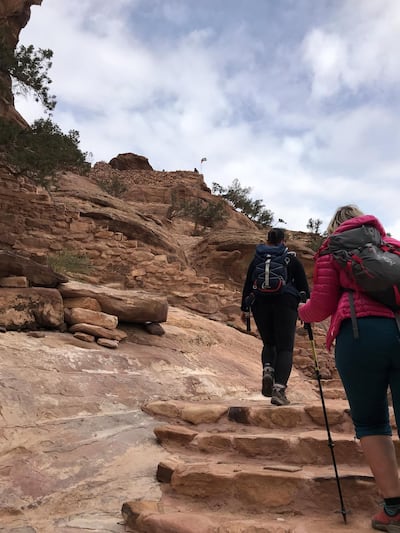
The next morning, we ditch the bikes and set out on a trek to Petra. We’re travelling with a local company called Terhaal Adventures and taking advantage of their intimate knowledge of the country to bypass the crowds, entering the Unesco site via a Bedouin backdoor trail instead. The two-hour hike takes us across rocks and over cliffs, stopping to rest at a tiny stall perched midway up a rock face where everyone is handed a cup of tea. No donation necessary; tea is seen as a bedrock of Jordanian hospitality.
We reach the Nabataean wonder that is The Monastery and have a crowd-free hour to absorb the magnificence of its rock-cut facade. When the tourists begin to arrive, we head out – traversing the stone steps of a Nabataean procession way towards The Treasury.
Petra is Jordan's most-visited tourism attraction – more than one million people came in 2019, and we soon meet some of those crowds. Thankfully, we're moving in different directions and an hour later, I'm awestruck as I stand face-to-face with the 2,000-year-old The Treasury, or Al-Khazneh in Arabic.
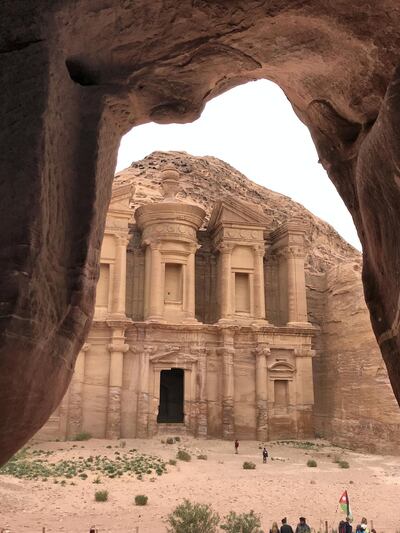
My alarm jerks me from a Nabataean-filled dream the next morning, signalling the start of the biggest challenge of the trip – a 70km cycle through the Jordanian desert. Climbing gingerly on to my saddle, I distract myself from the pain by watching the Arabian sunrise cast a pinkish glow over the upper rim of the Araba Valley. Today's ride begins in Wadi Musa and traverses a part of ancient road known as the King's Highway.
My muscles ache but the adrenalin is pumping and I remind myself to take it slow; it’s going to be a long day. We ride through the hills, where some of the road is tarmac and other parts are little more than dirt track.
At one point, we pass a UN Refugee Agency tent, outside of which a couple of children are playing in the rocks. Jordan is one of the countries most affected by the ongoing Syria crisis, and the country is home to more than 755,050 refugees. “Salam,” I shout, and the children wave as we disappear over the crest of the hill.

From here, we climb higher, passing farmhouses and stopping for an energy bar outside a brightly painted school on the road to Rajif. Three children from a house opposite come out to say hello, curious to find out more about the group of two-wheeled visitors on their doorstep.
Today's route is less steep than our warm-up cycle and I'm feeling quietly confident. My mood boost is helped by the fact that it's spring – it's hard to not enjoy cycling alongside fields dotted with wildflowers and over valleys that are turning green.
Going down
At 1,700 metres – as high as this section of the trail goes – Anas announces that we’ve passed the halfway mark. We continue through the hills, cycling in a single file to shield each other from a rapidly increasing wind. Thundering downhill, my bike naturally picks up speed and I can feel the wind as it whirls around my ears. I grip the rubber handlebars tightly, cementing me to the frame as I bump over boulders. The gradient is steep and the wheels anchoring me to the road spin faster and faster. My helmet rattles against my forehead as the terrain gets bumpier and I flick my gear switch, trying to get things back under control.
Ahead of me, a patch of orange sand has gathered in a ravine at the bottom of the hill – a fellow cyclist’s bike lies abandoned by the road, with the rider nearby, catching her breath. I grip the handlebars tighter, vowing not to join her, and push down on the pedals some more.
All of a sudden, there’s an eerie silence as the wheels of my bike make contact with the sand, eliminating the crunching of gravel. For the briefest of moments, I feel like I’m flying as my bike speeds silently over the desert. A few seconds later, I’m splayed on the ground. My bike lands a few paces away from me. Thanks to the cushioning of the sand, the only thing that is hurt is my pride. I get to my feet and scoot out of the way – conscious of the riders pedalling behind me.
Bedouin hospitality
Humiliation over, Anas checks that the bikes are OK and tells us to follow him to lunch. We trail him as he veers towards a black goat-hair tent. As we approach, a man emerges, dressed in a long grey thobe over a blue turtleneck, with a red-and-white shemagh on his head.
Abu Amar – as we learn is his name – greets Anas with a handshake and a touch of his nose, then motions for us to come inside. A little boy pops his head under the canvas, no doubt curious to see who the visitors are. These are Jordanian Bedouins living in the solitary expanse of the desert, making a living from the few animals they herd.
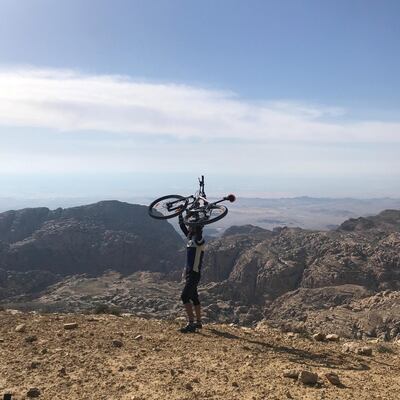
Hospitality is at the core of this nomadic culture. According to Bedouin tradition, guests are a gift from God and hosts cannot even ask a visitor arriving at their home why they are here. This continues for three days. On the fourth day, they can finally ask someone what their name is and the purpose of their visit. Inside the tent, we feel the extent of this hospitality – feasting on a hearty meal of lentil soup and lamb mansaf, washed down with a steaming cup of tea from a family we've never met before.
Fed and watered, it’s time to get back on our bikes. A few hours, dirt tracks and dried-up wadis later, we’re down a couple of cyclists who’ve retreated to the support vehicle. My legs are like jelly and I can feel blisters forming on my hands, but that’s all forgotten when the end of the trail finally comes into sight – I’ve made it.
The wilds of Rum
We leave the bikes with the technical team and clamber on to the bus to head to our final stop in Jordan, the wilds of Wadi Rum. Here, it’s time for a different type of riding as our hosts welcome us with their flock of friendly camels. I’m introduced to Ali – an off-white seven-year-old dromedary who has enviously long eyelashes, but less appealing body odour.
The caravan sets off at a steady pace, the camels’ two-toed feet navigating the dark sands of Rum with ease. Every few metres, Ali stops to munch on a weed or to nuzzle one of his camel buddies. Rocking gently with his pace, I sit back and drink in the surroundings.
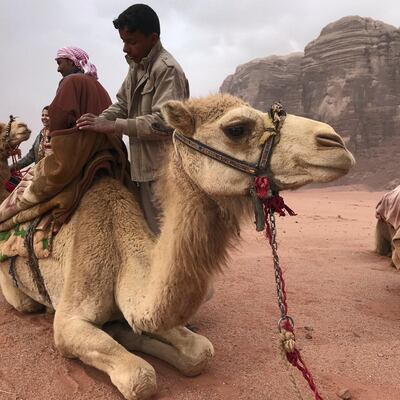
People have lived in Wadi Rum for thousands of years. Nestled in Jordan’s far south, the climate in this desert scape is harsh, but the scenery mesmerising. Gargantuan rock formations, massive mesas, smooth gorges and towering arches are swathed in rippled dunes and a sea of crimson sand grains – so coloured by naturally occurring iron oxide.
We soon arrive at the Bedouin-owned Salem’s Camp, where Salem himself is waiting to greet us. Here, each tent comes with a proper bed and a little window designed to let guests take in the desert panoramas from the comfort of their tent. There’s also solar-powered lights, proper bathrooms and working showers.

Salem invites us to join him in the community tent, where some of the other men have already lit an indoor fire and are using it to brew tea.
On the trail of history
I’m handed a cup by one of the boys and settle down on a cushion to hear Salem talk. He tells us his family have lived in this part of the world for centuries – his forefathers were among the tribesmen who fought alongside Lawrence of Arabia against the Ottoman Empire.
Yousef, one of Salam's younger relatives, sits near me playing on an iPhone. Salem is talking about the camels and says something to Yousef in the Bedouin dialect of Arabic that even most Jordanians cannot understand. He turns to show me a video on his phone – it's a baby camel. "This is Khidad, she's nine months old, and my favourite," he says proudly, before offering me yet another cup of tea.
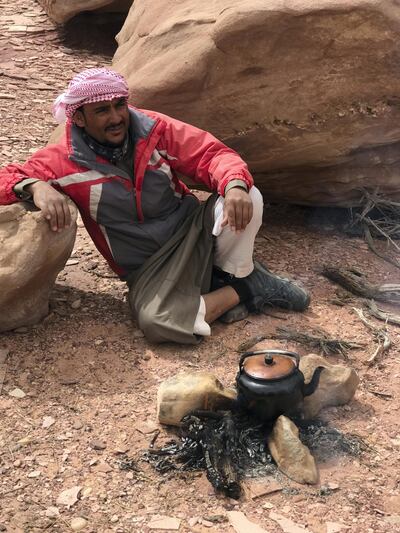
Just then, there's a shout from outside and we head out on to the sand for the spectacle that is dinner. In keeping with tradition, and with such a large group of people to feed, the family has slaughtered a goat. It's been cooking for hours in a traditional zarb, dug deep into the rust-coloured sand. Salem and a few of the other men gather around the pit, ready to pull it out of the ground. But first, there's a celebratory song, clapping and swaying – another bedrock of Bedouin life. Having been slow-roasted over hot charcoal, the goat is finally ready and the men hoist it carefully out of the sand.
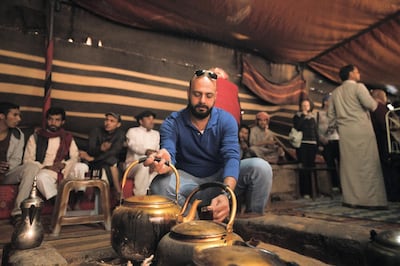
After dinner, we sit around the fire as Salem indulges in that favoured nomadic pastime of storytelling. We learn about his great, great, grandfather and how he led a battle between two desert tribes. He shows us pictures of his new baby daughter – the family don't live at the camp, but he brings his girls here to play when the weather isn't so cold. He tells us that Matt Damon slept here when in Jordan to film The Martian. It's hard to know whether to believe that last story or not, but either way, Salem is quite the host and I head back to my tent full of hot tea and heart-warming tales.
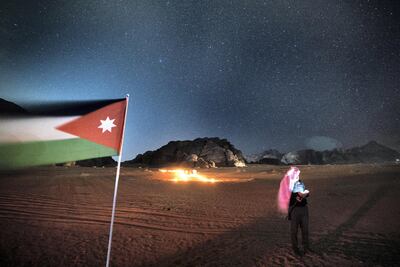
Inside, I open the tiny window and gaze out over the vastness of the dunes. The nighttime sky twinkles as if it’s alive – pulsating with the light of thousands of stars. In the distance, the full moon shines intensely, casting a milky glow on the tips of the mammoth rock formations. Whether Matt Damon slept in this camp or not, I do not know, but the actor did say that Wadi Rum was “like nothing I've ever seen anywhere else on Earth". And I wholeheartedly agree that this place is entirely otherworldly.
